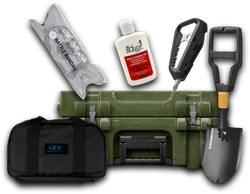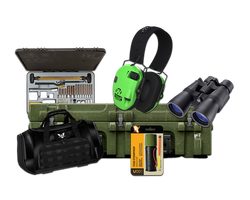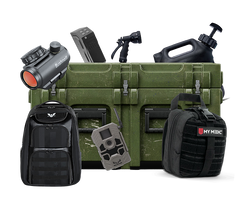What is Military Gear? A Comprehensive Guide
Table of Contents
- Introduction
- The Historical Context of Military Gear
- Categories of Military Gear
- The Role of Military Gear in Modern Warfare
- Crate Club: Your Source for Tactical Gear
- Conclusion
- FAQ
Introduction
Military gear encompasses a vast array of equipment, clothing, and accessories designed to enhance the operational capabilities of armed forces personnel. From protective gear that shields soldiers from harm to tactical clothing that offers comfort and functionality, military gear plays an essential role in ensuring the effectiveness and safety of military operations. In recent years, advancements in technology and materials have transformed military gear, making it more efficient, versatile, and adaptable to various combat scenarios.
Did you know that the U.S. military spends over $100 billion annually on procurement and maintenance of military equipment? This staggering figure underscores the importance of high-quality gear in maintaining national security and operational readiness. As tactical enthusiasts and survivalists, understanding military gear is not just about knowing what equipment exists; it’s about recognizing how this gear can be used to enhance your own preparedness and effectiveness in challenging situations.
In this blog post, we will explore the essential components of military gear, its evolution over time, and its relevance in both military and civilian contexts. By the end of this article, you will have a comprehensive understanding of what military gear is, its importance, and how it can empower you to be better prepared for any situation.
The Historical Context of Military Gear
Military gear has evolved significantly since the inception of organized armed forces. In ancient times, soldiers relied on rudimentary weapons and basic protective gear made from natural materials such as leather and animal hides. As warfare progressed, so too did the technology and design of military equipment.
Key Milestones in Military Gear Evolution
-
Medieval Armor: The introduction of metal armor during the medieval period provided soldiers with superior protection against weapons of that era. Full suits of armor became prevalent among knights, showcasing the importance of protection in combat.
-
World War I and II: The two World Wars marked a significant turning point in military gear. The introduction of standardized uniforms, body armor, and advanced weaponry transformed the battlefield. Innovations like helmets, gas masks, and tactical clothing were developed to address specific wartime challenges.
-
Modern Era: Today, military gear is a blend of high-tech materials, advanced design, and modular systems. The advent of lightweight body armor, advanced optics, and communication devices has revolutionized how soldiers operate in the field.
Understanding this historical context is crucial, as it highlights the ongoing need for innovation and adaptation in military gear. As threats evolve, so too must the tools and equipment used to combat them.
Categories of Military Gear
Military gear can be broadly categorized into several key areas, each serving a specific purpose in enhancing soldier effectiveness and safety. Here are the primary categories of military gear:
1. Protective Gear
Protective gear is designed to shield soldiers from various threats, including gunfire, shrapnel, and environmental hazards. This category includes:
- Body Armor: Bulletproof vests and plate carriers that provide vital protection against ballistic threats.
- Helmets: Tactical helmets equipped with ballistic protection and attachments for night vision devices and communication systems.
- Eye Protection: High-quality ballistic eyewear to protect against debris and UV rays.
- Gloves and Knee Pads: Tactical gloves for enhanced grip and knee pads for protection during movement.
2. Firearms, Ammunition, and Accessories
Firearms are a fundamental component of military gear. This category encompasses:
- Primary Weapons: Standard-issue rifles and carbines, such as the M4 and M16.
- Optics and Lasers: Red dot sights, holographic sights, and magnified scopes for improved targeting.
- Ammunition: Various types of ammunition tailored to mission requirements.
- Accessories: Vertical grips, suppressors, and slings for enhanced weapon control and functionality.
3. Night Vision and Optics
Night vision devices and optics enhance visibility and targeting capabilities in low-light conditions. This includes:
- Night Vision Goggles: Devices that amplify available light for improved nighttime vision.
- Thermal Optics: Equipment that detects heat signatures, allowing for target detection in complete darkness.
- Rangefinders: Tools that measure the distance to a target, essential for precise shooting.
4. Load-Bearing Equipment
Load-bearing equipment (LBE) is critical for carrying essential gear while maintaining mobility. Key features include:
- Modularity: Systems designed to allow customization based on mission requirements.
- Weight Distribution: Equipment designed to evenly distribute weight across the body.
- Durability: Constructed from high-quality materials to withstand harsh conditions.
5. Tactical Clothing
Tactical clothing is designed for functionality and durability. Key characteristics include:
- Durability: Made from robust materials that resist wear and tear.
- Functionality: Incorporates features such as multiple pockets and articulated designs for ease of movement.
- Camouflage: Patterns that help blend into various environments to enhance concealment.
6. Communication and Navigation
Effective communication and navigation are vital for operational success. This category includes:
- Radios: Portable communication devices for team coordination.
- GPS Devices: Tools for accurate positioning and route planning.
- Tactical Headsets: Devices that facilitate communication in noisy environments.
7. Medical Equipment
Medical equipment is essential for providing immediate care in the field. This includes:
- Individual First Aid Kits (IFAK): Compact kits containing essential medical supplies.
- Tourniquets and Hemostatic Agents: Life-saving tools for controlling bleeding.
8. Survival and Outdoor Gear
Survival gear is critical for scenarios that require self-sufficiency. This includes:
- Multi-tools: Versatile tools with various functions for different situations.
- Flashlights: Handheld or weapon-mounted lights for visibility in dark conditions.
Understanding these categories provides a clear picture of what military gear comprises and its significance in both military operations and civilian preparedness.
The Role of Military Gear in Modern Warfare
Military gear is not only about personal protection; it plays a pivotal role in the effectiveness of military operations. Here are some key aspects of its role in modern warfare:
1. Enhanced Survivability
The primary goal of military gear is to enhance survivability. With threats evolving, the need for durable, high-quality gear is paramount. Body armor and helmets help protect soldiers from gunfire and shrapnel, while tactical clothing and load-bearing systems ensure comfort and mobility.
2. Improved Tactical Efficiency
Modern military gear is designed to improve tactical efficiency. Equipment like modular load-bearing systems allows soldiers to carry essential gear without compromising mobility. Additionally, advanced optics and communication systems enhance situational awareness, allowing for more effective decision-making on the battlefield.
3. Adaptability to Diverse Environments
Military operations often take place in various environments, from urban settings to mountainous terrains. The versatility of modern military gear allows soldiers to adapt to these diverse conditions. For example, the use of camouflage patterns helps soldiers blend into their surroundings, reducing visibility to the enemy.
4. Integration of Technology
The integration of technology into military gear has transformed how soldiers operate. Innovations such as smart helmets with integrated communication systems and night vision devices have revolutionized battlefield capabilities. This technological advancement enhances the effectiveness of military personnel and increases mission success rates.
5. Psychological Impact
High-quality military gear also has a psychological impact on both soldiers and adversaries. Soldiers equipped with advanced gear feel more confident and prepared for the challenges ahead. Conversely, the sight of well-equipped soldiers can deter potential adversaries, impacting their willingness to engage in conflict.
Crate Club: Your Source for Tactical Gear
As a leading provider of curated tactical gear and survival tools, Crate Club offers a subscription service that delivers high-quality military gear directly to your doorstep. With four subscription tiers—Lieutenant, Captain, Major, and General—Crate Club provides options for everyone, from casual outdoor enthusiasts to experienced survivalists. Each subscription is designed to help you be better prepared for whatever life throws your way.
- Lieutenant Tier ($49.99/month): Perfect for newcomers, this tier includes survival tools, self-defense gear, and EDC essentials, with an average value of $89.
- Captain Tier ($99.99/month): For those looking for a robust mix of survival and tactical gear, this tier offers an average value of $153.
- Major Tier ($199.99/month): This tier provides premium gear, including advanced optics and purification systems, with an average value of $305.
- General Tier ($399.99/quarterly): The ultimate choice for serious tacticians, this tier includes professional-grade gear with an average value of $561.
To explore Crate Club's subscription options, visit Crate Club Subscription Services.
In addition to subscriptions, Crate Club offers a wide range of tactical gear in their shop, including essential items for any tactical enthusiast. Check out the offerings at Crate Club Shop to find gear that suits your needs.
Conclusion
Military gear is a critical aspect of operational effectiveness and personal safety in both military and civilian contexts. From protective clothing and weapons to communication devices and medical supplies, understanding the components of military gear empowers individuals to be better prepared for various situations.
As technology continues to advance, military gear will evolve, becoming more effective and versatile. By staying informed about the latest developments in military gear and investing in high-quality equipment, you can enhance your readiness for any challenge.
Embrace the tactical mindset and equip yourself with the best gear available. Whether you're a soldier, a survivalist, or an outdoor enthusiast, having the right military gear can make all the difference in ensuring your safety and success.
FAQ
Q1: What is military gear? A1: Military gear refers to the equipment, clothing, and accessories used by armed forces personnel to enhance their operational capabilities and safety during combat operations.
Q2: What types of military gear are available? A2: Military gear can be categorized into protective gear, firearms and ammunition, night vision and optics, load-bearing equipment, tactical clothing, communication and navigation tools, medical equipment, and survival gear.
Q3: How has military gear evolved over time? A3: Military gear has evolved from basic protective items made of natural materials to advanced, high-tech equipment designed for specific combat scenarios. Innovations in materials and technology have significantly enhanced the effectiveness and adaptability of military gear.
Q4: How can I purchase military gear? A4: You can purchase military gear through various retailers, including specialized tactical gear shops and online platforms. Crate Club offers a subscription service that delivers curated tactical gear directly to your door.
Q5: Why is it important to have quality military gear? A5: Quality military gear enhances survivability, improves tactical efficiency, and provides adaptability to diverse environments, ultimately increasing the likelihood of mission success and personal safety.
Share this article



